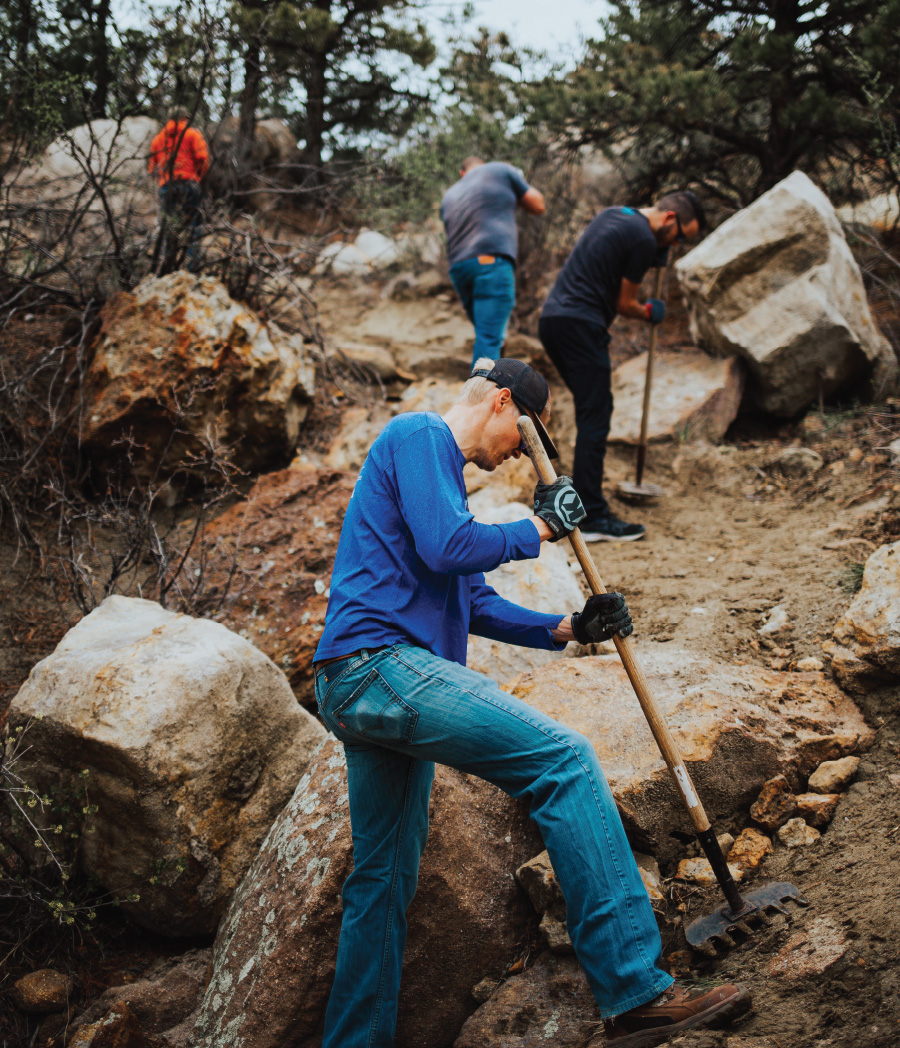TRAILBLAZER
Keith Thompson is a trail builder. When he’s on the clock, Thompson works as the Director of Engagement for CONO, a non-profit that empowers and equips neighborhoods to engage with local governments on civic issues. That’s his day job. In his free time, Thompson is an avid mountain biker. Two or three times a week, he rides trails across Colorado Springs. But in the past year, Thompson has found that his job as a bridge builder between local communities and city government has carried over into his sport.
Over the past twenty years, there has been a growing disconnect between the Parks Service and the needs of the mountain bike community. Modern mountain biking is a relatively new sport. The first mountain bikes were manufactured in the early 80s. Since then, technology and riders have progressed exponentially; someone now considered an intermediate rider can perform at a level that only highly advanced riders could twenty years ago.
“The reality is that the bell curve is not really a bell curve,” Thompson says. “The vast majority of riders are either advanced-intermediate or advanced.”
Along with the increased performance of the mountain bike community has come a greater demand for more intensive features and steeper terrain.
Unfortunately, the Parks Service was unaware of the sport’s progression and could not keep up with the community’s growing need for more advanced trails. They had plans to continue building more beginner and intermediate trails, but Colorado Springs only has a few advanced trails. As a result, local riders took matters into their own hands and began digging their own unauthorized “rogue trails”’ on public land so they could ride at their skill level.
The problem is that rogue trails are dangerous to riders and the environment. Because they are not a part of the official trail system, they are not monitored by the Parks Service. That means if a rider were to be injured, it could be hours or days before someone found them. Also, because rogue trails are built without consulting the Parks Service, they are typically not made with the same awareness for erosion or local plants and animals that the Parks Service has. But because rogue trails are the only place most riders can ride at their ability level in the city, they are incredibly popular.
“If you are an advanced rider in Colorado Springs,” Keith told me, “50% of the riding you do is on rogue trails.”
Ironically mountain bikers were making their situation worse by digging their own trails. Not only was the development of these trails causing more conflict between riders and the Parks Service, but time and money that could have been allocated to build more trails was being used to dismantle rogue trail systems.
Thompson was incredibly frustrated when he discovered that a space had already been approved in Austin Bluffs Open Space for an advanced bike trail, but there were no plans to build it. He knew from experience that if he wanted this trail to be built, he couldn’t just tell the Parks Service to dig it. He would need to work alongside them.
“If I simply tell them they need to catch up, they won’t listen. But if I go and I give my time and help them, and while I’m doing that, I prove to them that I know what I’m talking about, they are more likely to listen and take it to heart.”
So Thompson went to the Parks Service and pitched the idea. He and his friends would volunteer to dig the trail for them. As an added benefit, most of Thompson’s friends were the ones digging all of the rogue trails across town, and this began directing their energy away from rogue trails and toward an approved project which would be a win both for riders and the city.
The Parks Service said yes, and the impact of the collaboration was almost immediate. When rangers showed Keith and the other riders the land approved for the trail, they saw the potential that the rangers couldn’t. The alignment that Thompson and his friends proposed differed from what the rangers expected, and initially, they didn’t like it. According to their guidelines, it would be too steep and technical. Eventually, through conversation and working together, Thompson and his friends earned the trust of the Parks Service and convinced them that their proposed alignment was what riders in the Springs wanted.
Once the project began, Thompson and the other riders made an intentional effort for the trail, lovingly named “Black Sheep,” to be a community-building project. They wanted it to be an opportunity for the mountain bike community to come together and show the city what they could do.
“I wanted to prove to local riders that we can do this level of project without needing to raise $100k. By design, Black Sheep had no sponsorships, no partnerships, and no help. It was meant to be super grassroots. We built and opened the first quarter mile of trail with $0 invested.” No one person designed the trail. The final alignment, trajectory, and features were all decided communally by a group of about forty riders.

The Parks Service took advantage of the dig days and used them as a time for reconciliation and relationship-building with the mountain bike community. Every dig day, a different ranger was introduced to the riders and would work with them. The very riders that were hiding from park rangers and building rogue trails were now digging alongside rangers to build Black Sheep. The collaboration was a complete success. Fifty-five riders volunteered over seven dig days to construct the quarter-mile trail rock by rock. By the end of it, the riders had a new advanced trail in the Springs, and the Parks Service had a better relationship with the mountain bike community.
After the success of Thompson and his friends’ grassroots approach to Black Sheep, the mountain bike community wanted to keep the momentum going. And so Thompson started the Colorado Springs Mountain Bike Association (COSMBA) to “build the community and identity of what it means to be a mountain biker in Colorado Springs.” The association is excited to continue advocating for the sport to promote three core values: community, trails, and stewardship. The Parks Service has trusted the association with several more projects and is giving them more creative freedom in their chosen features and alignments. COSMBA has plans this summer to improve trails in Blodgett Open Space, Stratton Open Space, and North Cheyenne Canyon. They also plan to extend Black Sheep, making it a half-mile long.

According to Thompson, it will be the most challenging mountain bike trail in Colorado Springs once it is finished.
Keith is excited about what lies ahead for COSMBA. The sport has been historically male-dominated, but the association is made up of mountain bikers from a diverse set of backgrounds and riding abilities. “The group represents the entire mountain bike community, not just the top five percent.” They recently held a launch night at Red Leg Brewing and have several group rides planned for this summer.
Trail building is not easy work—it’s a lot of digging and moving big rocks. Often, they’re hiking heavy equipment to and from the dig site. For Keith, it’s special to see the Colorado Springs mountain bike community caring about their sport enough to spend their weekends in the sun building trails for the city. What’s even sweeter is that in the process, the community became even more connected than before and reconciled with the Parks Service. A quarter-mile trail is all it took to get people working for one another instead of against each other.
If you want to get plugged in with the mountain bike community in the Springs or volunteer with one of their upcoming dig days, go to www.COSMBA.org to connect.


